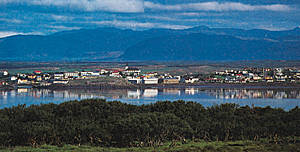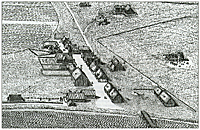

Some thoughts on social and aesthetic space, present and past
By Ólafur Gíslason
Just about two years ago, I undertook to guide a group of Italian visitors from Naples around Iceland. There had been a heat wave in the Bay of Naples and the group arrived on a cool, sunny June evening, pleased and refreshed. The following morning, we were in Borgarnes, on one of those cold bright days of early summer, when the chilly weather from the north leaves a touch of frost on the puddles in the morning, in spite of the brightens of the night, which kept the travellers awake that first night in Iceland, and reminded them that they were far from home.
This was our first stop on a long journey, and we made a brief tour of the village before disembarking from the bus. Hardly had we taken our first breath of the cool, refreshing morning air, when a brisk, bearded, pipe-smoking man about 50 turned to me and said: ‘How is it that there is no centre to this town? This village is not even really a town by our definition -- the houses have been put here and there, apparently at random, without any sign that planning or conscious thought has been at work. Are most of your towns build this way?’
I must admit that his question took me by surprise, and I hardly knew how to respond. Something in my upbringing, or some customary way of thinking, had blinded me to an obvious fact, which this newcomer perceived as soon as he saw the town. It was not the beautiful mountain panorama, or the lovely location of the town of Borgarnes that struck him, but something culturally alien which he saw in the incoherent, widely dispersed community which the village, in fact, is.
I was to become better aquatinted with this observant visitor. He took a keen interest in old Icelandic architecture, wherever it was to be seen, and I discovered that he was a landscape architect, who had planned national parks in southern Italy. We had other opportunities to discuss these matters after seeing other Icelandic communities and villages -- for example, Stykkishólmur. He pointed out to me that there is a crucial difference between Icelandic/Nordic communities and those of southern Europe. The towns and cities of Italy and southern Europe in general have their roots in the Greek polis, he said, where the square or piazza is the centre of the community, and place of assembly, as well as functioning as a courtyard to the buildings which represent spiritual and temporal authority, whether temple and basilica/courthouse, or cathedral and town hall. There is no Italian village so small that it has no such centre, which functions as the focus of social life, and the centre of the web spun by community life. ‘In your country, each person is enclosed in his house, and the town’s plan gives no indication of social ties in society,’ the landscape architect remarked. He attributed this partly to the climate, and partly to a different cultural background.
This story is recounted here, on the occasion of a Nordic exhibition of environmental works of art and concepts for such works because it is not enough for us to concentrate on the different principles behind interior and exterior works of art (the exhibition, Nordic Wells, took place at the Nordic House in Reykjavik in the autumn of 1995). We must also consider spatial perceptions as such, their basis and treatment. It is not chance that decides how our environment and the space around us are formed. Long traditions and history have their influence, and these are social and economic as well as aesthetic. Thus we are not only able to perceive a geographical difference between the classical and Nordic concept of space; spatial concepts also changed over the centuries both in southern and northern Europe, and these changes have generally coincided with radical changes in other areas of national life, whether economic, ideological or political.
History of space
The concept of space which prevailed during the medieval period of feudalism in Europe was entirely different from the spatial awareness which emerged in the Renaissance, with a growing bourgeoisie, more extensive division of labour, and altered methods of business and communication. This new picture of the world also changed Man’s conception of space as such, and created new conditions and a new environment for development in the arts, architecture and planing.
During the seventeenth century, the avenue came into existence, in European cities, establishing links between institutions of power in a society which had grown more complex due to increased division of labour and new needs. Exterior space acquired a new role and a new significance in the cityscape, which as increasingly perceived as the background or theatre for human life. Then the spatial awareness of the Enlightenment in the eighteenth century was shaped by the cool rationalism of the neo-classical style.
Icelandic society, a community of farms, missed out on almost all these developments in spatial awareness and town planning that took place in Europe, and which may be traced back to the Greek city-state. Probably Iceland is unique in Europe in that there is scarcely any discernible development in architecture from the Middle Ages until modern times, with the exception of the Episcopal seats. Even there, no development took place from the building of Skálhot Cathedral by Bishop Brynjólfur in 1650 until about 1800. When urban development eventually began in Iceland, it was defined by the rules of the unique rural society which had developed, where the owner-farmer was predominant. But in what way did the spatial awareness of Icelandic rural society differ from the classical tradition in the shaping of towns and urban communities?
If we consider the medieval European town, where feudalism and the monarchy prevailed, we see at once that the medieval town is separated by its defensive walls from untamed nature outside the walls. The community (Latin civitas) was built around the centre, where the cathedral and the palace of the feudal lord stood. It was a safe haven, also for the impoverished peasant farmers who lived within the walls, while nature outside was wild, uncertain and threatening -- the opposite of civitas, the civilisation of urban life.
Iceland’s farming society was not feudal in the same sense, but was based primarily upon subsistence farming, the cornerstone of which was the owner-farmer. When Icelandic farmers began to build urban centres along the coast in the late nineteenth century, they considered the space of the town from the viewpoint of subsistence farming; hence they built up a dispersed community in keeping with the individualism of the small farmer, rather than arranging it according to common social aims. The space of the town was not separated from nature, but was interwoven with it, and hence became a part of nature. The definition of common space in Icelandic farming society differed inevitably from the definitions which were rooted in the Greek city-state with its democratic tradition, its square and its town centre. What sets Iceland apart, however, is the fact that we see these ideas, rooted in farming society, still flourishing today in town planning, especially in smaller communities.
Classical space in Iceland
The classical concept of space was hardly known in Iceland prior to the Enlightenment. The first street which came into existence in Iceland, Adalstræti (Main Street) in Reykjavik, was built up in connection with an attempt by Skúli Magnússon, High Sheriff, to launch small-scale craft industries in the mid-eighteenth century. Sjórnarrádshúsid (Government House), which may probably be defined as a mixture of baroque and neo-classicism, was built in 1761. From Adalstræti developed in due course Iceland’s first square, Austurvöllur, where in 1880 the parliament building was built, an example of neo-renaissance. In the centre of the square, opposite parliament, Iceland’s first environmental work of art, in the modern sense, was erected. This was a cast of a self-portrait of Bertel Thorvaldsen, a gift to Iceland in 1874. While Thorvaldsen was half-Icelandic on his father side, his art was not Icelandic but international neo-classicism, rooted in Greek and Roman classical art on the one hand, and in central European rationalism on the other.
It was not until well into the twentieth century that Iceland acquired the potential to share the spatial conceptions of other European nations. This is clearly demonstrated in our surroundings, even in the present day, in such lovely towns as Borgarnes and Stykkishólmur, which preserve in their own town plan the natural and spatial conceptions of rural society, although modern industry and lifestyle are firmly established there. The spatial awareness of rural society is not only seen in town planning here in Iceland. It also forms the basis of Icelandic artistic tradition. Thus the Icelandic tradition of art is almost exclusively linked to pure craftsmanship until the twentieth century. A society which has no classical space in its urban environment scarcely has the need, imagination or resources to create pure, fine arts. Yet the results achieved by the pioneers of modern art in Iceland in the early twentieth century are no less than astonishing: Thorarinn B. Thorláksson, Einar Jónsson, Ásgrímur Jónsson and Jóhannes Kjarval thrust Iceland into the twentieth century in an extraordinary manner, at the same time as they created art which was firmly rooted in rural society’s narrative tradition and close ties with nature.

|
|
|
|
|
|
|
|